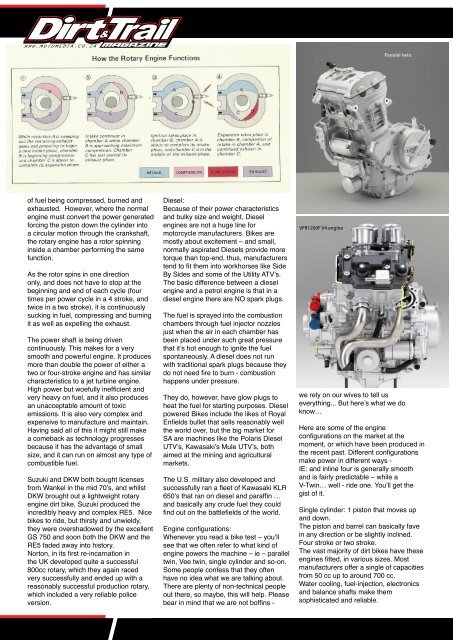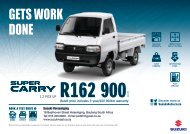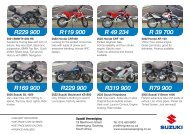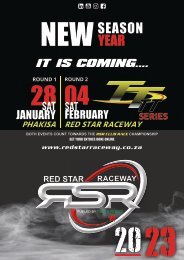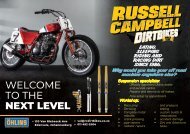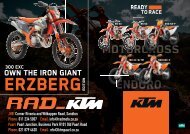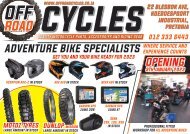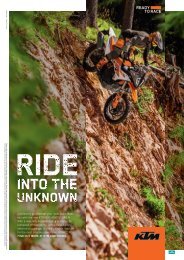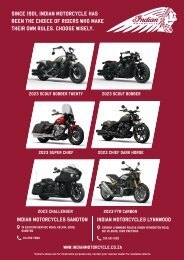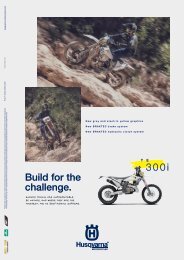Dirt ad Trail Online Nov 2020
Create successful ePaper yourself
Turn your PDF publications into a flip-book with our unique Google optimized e-Paper software.
Parralel twin.<br />
of fuel being compressed, burned and<br />
exhausted. However, where the normal<br />
engine must convert the power generated<br />
forcing the piston down the cylinder into<br />
a circular motion through the crankshaft,<br />
the rotary engine has a rotor spinning<br />
inside a chamber performing the same<br />
function.<br />
As the rotor spins in one direction<br />
only, and does not have to stop at the<br />
beginning and end of each cycle (four<br />
times per power cycle in a 4 stroke, and<br />
twice in a two stroke), it is continuously<br />
sucking in fuel, compressing and burning<br />
it as well as expelling the exhaust.<br />
The power shaft is being driven<br />
continuously. This makes for a very<br />
smooth and powerful engine. It produces<br />
more than double the power of either a<br />
two or four-stroke engine and has similar<br />
characteristics to a jet turbine engine.<br />
High power but woefully inefficient and<br />
very heavy on fuel, and it also produces<br />
an unacceptable amount of toxic<br />
emissions. It is also very complex and<br />
expensive to manufacture and maintain.<br />
Having said all of this it might still make<br />
a comeback as technology progresses<br />
because it has the <strong>ad</strong>vantage of small<br />
size, and it can run on almost any type of<br />
combustible fuel.<br />
Suzuki and DKW both bought licenses<br />
from Wankel in the mid 70’s, and whilst<br />
DKW brought out a lightweight rotary<br />
engine dirt bike, Suzuki produced the<br />
incredibly heavy and complex RE5. Nice<br />
bikes to ride, but thirsty and unwieldy,<br />
they were oversh<strong>ad</strong>owed by the excellent<br />
GS 750 and soon both the DKW and the<br />
RE5 f<strong>ad</strong>ed away into history.<br />
Norton, in its first re-incarnation in<br />
the UK developed quite a successful<br />
800cc rotary, which they again raced<br />
very successfully and ended up with a<br />
reasonably successful production rotary,<br />
which included a very reliable police<br />
version.<br />
Diesel:<br />
Because of their power characteristics<br />
and bulky size and weight, Diesel<br />
engines are not a huge line for<br />
motorcycle manufacturers. Bikes are<br />
mostly about excitement – and small,<br />
normally aspirated Diesels provide more<br />
torque than top-end, thus, manufacturers<br />
tend to fit them into workhorses like Side<br />
By Sides and some of the Utility ATV’s.<br />
The basic difference between a diesel<br />
engine and a petrol engine is that in a<br />
diesel engine there are NO spark plugs.<br />
The fuel is sprayed into the combustion<br />
chambers through fuel injector nozzles<br />
just when the air in each chamber has<br />
been placed under such great pressure<br />
that it’s hot enough to ignite the fuel<br />
spontaneously. A diesel does not run<br />
with tr<strong>ad</strong>itional spark plugs because they<br />
do not need fire to burn - combustion<br />
happens under pressure.<br />
They do, however, have glow plugs to<br />
heat the fuel for starting purposes. Diesel<br />
powered Bikes include the likes of Royal<br />
Enfields bullet that sells reasonably well<br />
the world over, but the big market for<br />
SA are machines like the Polaris Diesel<br />
UTV’s, Kawasaki’s Mule UTV’s, both<br />
aimed at the mining and agricultural<br />
markets.<br />
The U.S. military also developed and<br />
successfully ran a fleet of Kawasaki KLR<br />
650’s that ran on diesel and paraffin …<br />
and basically any crude fuel they could<br />
find out on the battlefields of the world.<br />
Engine configurations:<br />
Whenever you re<strong>ad</strong> a bike test – you’ll<br />
see that we often refer to what kind of<br />
engine powers the machine – ie – parallel<br />
twin, Vee twin, single cylinder and so-on.<br />
Some people confess that they often<br />
have no idea what we are talking about.<br />
There are plenty of non-technical people<br />
out there, so maybe, this will help. Please<br />
bear in mind that we are not boffins -<br />
VFR1200F V4 engine<br />
we rely on our wives to tell us<br />
everything... But here’s what we do<br />
know…<br />
Here are some of the engine<br />
configurations on the market at the<br />
moment, or which have been produced in<br />
the recent past. Different configurations<br />
make power in different ways -<br />
IE: and inline four is generally smooth<br />
and is fairly predictable – while a<br />
V-Twin… well - ride one. You’ll get the<br />
gist of it.<br />
Single cylinder: 1 piston that moves up<br />
and down.<br />
The piston and barrel can basically fave<br />
in any direction or be slightly inclined.<br />
Four stroke or two stroke.<br />
The vast majority of dirt bikes have these<br />
engines fitted, in various sizes. Most<br />
manufacturers offer a single of capacities<br />
from 50 cc up to around 700 cc.<br />
Water cooling, fuel-injection, electronics<br />
and balance shafts make them<br />
sophisticated and reliable.


